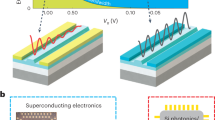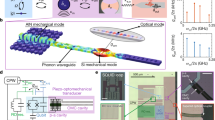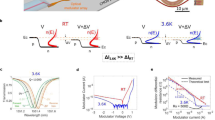Abstract
Delivering on the revolutionary promise of a universal quantum computer will require processors with millions of quantum bits (qubits)1,2,3. In superconducting quantum processors4, each qubit is individually addressed with microwave signal lines that connect room-temperature electronics to the cryogenic environment of the quantum circuit. The complexity and heat load associated with the multiple coaxial lines per qubit limits the maximum possible size of a processor to a few thousand qubits5. Here we introduce a photonic link using an optical fibre to guide modulated laser light from room temperature to a cryogenic photodetector6, capable of delivering shot-noise-limited microwave signals directly at millikelvin temperatures. By demonstrating high-fidelity control and readout of a superconducting qubit, we show that this photonic link can meet the stringent requirements of superconducting quantum information processing7. Leveraging the low thermal conductivity and large intrinsic bandwidth of optical fibre enables the efficient and massively multiplexed delivery of coherent microwave control pulses, providing a path towards a million-qubit universal quantum computer.
This is a preview of subscription content, access via your institution
Access options
Access Nature and 54 other Nature Portfolio journals
Get Nature+, our best-value online-access subscription
$29.99 / 30 days
cancel any time
Subscribe to this journal
Receive 51 print issues and online access
$199.00 per year
only $3.90 per issue
Buy this article
- Purchase on Springer Link
- Instant access to full article PDF
Prices may be subject to local taxes which are calculated during checkout




Similar content being viewed by others
Data availability
The experimental data and numerical simulations presented here are available from the corresponding authors upon request.
References
Fowler, A. G., Mariantoni, M., Martinis, J. M. & Cleland, A. N. Surface codes: towards practical large-scale quantum computation. Phys. Rev. A 86, 032324 (2012).
Reiher, M., Wiebe, N., Svore, K. M., Wecker, D. & Troyer, M. Elucidating reaction mechanisms on quantum computers. Proc. Natl Acad. Sci. USA 114, 7555–7560 (2017).
Gidney, C. & Ekerå, M. How to factor 2048 bit RSA integers in 8 hours using 20 million noisy qubits. Preprint at https://arxiv.org/abs/1905.09749 (2019).
Krantz, P. et al. A quantum engineer’s guide to superconducting qubits. Appl. Phys. Rev. 6, 021318 (2019).
Krinner, S. et al. Engineering cryogenic setups for 100-qubit scale superconducting circuit systems. EPJ Quantum Technol. 6, 2 (2019).
Davila-Rodriguez, J. et al. High-speed photodetection and microwave generation in a sub-100-mK environment. In 2019 Conf. Lasers and Electro-Optics (CLEO) SF2N.1 (2019)
Devoret, M. H. & Schoelkopf, R. J. Superconducting circuits for quantum information: an outlook. Science 339, 1169–1174 (2013).
Ofek, N. et al. Extending the lifetime of a quantum bit with error correction in superconducting circuits. Nature 536, 441–445 (2016).
Arute, F. et al. Quantum supremacy using a programmable superconducting processor. Nature 574, 505–510 (2019).
Andersen, C. K. et al. Repeated quantum error detection in a surface code. Nat. Phys. 16, 875–880 (2020).
Blais, A., Girvin, S. M. & Oliver, W. D. Quantum information processing and quantum optics with circuit quantum electrodynamics. Nat. Phys. 16, 247–256 (2020).
Andrews, R. W. et al. Bidirectional and efficient conversion between microwave and optical light. Nat. Phys. 10, 321–326 (2014).
Rueda, A. et al. Efficient microwave to optical photon conversion: an electro-optical realization. Optica 3, 597–604 (2016).
Jiang, W. et al. Efficient bidirectional piezo-optomechanical transduction between microwave and optical frequency. Nat. Commun. 11, 1166 (2020).
Mirhosseini, M., Sipahigil, A., Kalaee, M. & Painter, O. Superconducting qubit to optical photon transduction. Nature 588, 599–603 (2020).
Magnard, P. et al. Microwave quantum link between superconducting circuits housed in spatially separated cryogenic systems. Phys. Rev. Lett. 125, 260502 (2020).
Tuckerman, D. B. et al. Flexible superconducting Nb transmission lines on thin film polyimide for quantum computing applications. Supercond. Sci. Technol. 29, 084007 (2016).
Smith, J. P. et al. Flexible coaxial ribbon cable for high-density superconducting microwave device arrays. IEEE Trans. Appl. Supercond. 31, 2500105 (2021).
McDermott, R. et al. Quantum–classical interface based on single flux quantum digital logic. Quantum Sci. Technol. 3, 024004 (2018).
Leonard, E. et al. Digital coherent control of a superconducting qubit. Phys. Rev. Appl. 11, 014009 (2019).
Bardin, J. C. et al. Design and characterization of a 28-nm bulk-CMOS cryogenic quantum controller dissipating less than 2 mW at 3 K. IEEE J. Solid-State Circuits 54, 3043–3060 (2019).
Youssefi, A. et al. Cryogenic electro-optic interconnect for superconducting devices. Preprint at https://arxiv.org/abs/2004.04705 (2020).
de Cea, M. et al. Photonic readout of superconducting nanowire single photon counting detectors. Sci. Rep. 10, 9470 (2020).
Capmany, J. & Novak, D. Microwave photonics combines two worlds. Nat. Photon. 1, 319–330 (2007).
Saleh, B. E. A. & Teich, M. C. Fundamentals of Photonics (Wiley-Interscience, 2007).
Koch, J. et al. Charge-insensitive qubit design derived from the Cooper pair box. Phys. Rev. A 76, 042319 (2007).
Paik, H. et al. Observation of high coherence in Josephson junction qubits measured in a three-dimensional circuit QED architecture. Phys. Rev. Lett. 107, 240501 (2011).
Walter, T. et al. Rapid high-fidelity single-shot dispersive readout of superconducting qubits. Phys. Rev. Appl. 7, 054020 (2017).
Claudon, J., Balestro, F., Hekking, F. W. J. & Buisson, O. Coherent oscillations in a superconducting multilevel quantum system. Phys. Rev. Lett. 93, 187003 (2004).
Schuster, D. I. et al. a.c. Stark shift and dephasing of a superconducting qubit strongly coupled to a cavity field. Phys. Rev. Lett. 94, 123602 (2005).
Gambetta, J. et al. Qubit–photon interactions in a cavity: measurement-induced dephasing and number splitting. Phys. Rev. A 74, 042318 (2006).
Yan, F. et al. The flux qubit revisited to enhance coherence and reproducibility. Nat. Commun. 7, 12964 (2016).
Winzer, P. J., Neilson, D. T. & Chraplyvy, A. R. Fiber-optic transmission and networking: the previous 20 and the next 20 years. Opt. Express 26, 24190–24239 (2018).
Preskill, J. Quantum computing in the NISQ era and beyond. Quantum 2, 79 (2018).
Smith, T. L., Anthony, P. J. & Anderson, A. C. Effect of neutron irradiation on the density of low-energy excitations in vitreous silica. Phys. Rev. B 17, 4997 (1978).
Gambetta, J. et al. Quantum trajectory approach to circuit QED: quantum jumps and the Zeno effect. Phys. Rev. A 77, 012112 (2008).
Clerk, A. A. & Utami, D. W. Using a qubit to measure photon-number statistics of a driven thermal oscillator. Phys. Rev. A 75, 042302 (2007).
Houck, A. A. et al. Controlling the spontaneous emission of a superconducting transmon qubit. Phys. Rev. Lett. 101, 080502 (2008).
Nigg, S. E. et al. Black-box superconducting circuit quantization. Phys. Rev. Lett. 108, 240502 (2012).
Boyd, R. W. Radiometry and the Detection of Optical Radiation (Wiley, 1983).
Yariv, A. & Yeh, P. Photonics: Optical Electronics in Modern Communications 5th edn (Oxford Univ. Press, 1997).
Lecocq, F. et al. Nonreciprocal microwave signal processing with a field-programmable Josephson amplifier. Phys. Rev. Appl. 7, 024028 (2017).
W. Liu, R. Cendejas, H. Cao, Q. Hang, Z. Ji, and A. Nikolov, Uncooled low-bias uni-traveling carrier photodetectors. In 2013 Conf. Lasers and Electro-Optics (CLEO) Science and Innovations OSA Technical Digest CTh3L.2 (OSA 2013).
Zielinski, E., Schweizer, H., Streubel, K., Eisele, H. & Weimann, G. Excitonic transitions and exciton damping processes in InGaAs/InP. J. Appl. Phys. 59, 2196 (1986).
Yeh, J.-H., LeFebvre, J., Premaratne, S., Wellstood, F. C. & Palmer, B. S. Microwave attenuators for use with quantum devices below 100 mK. J. Appl. Phys. 121, 224501 (2017).
Wang, Z. et al. Cavity attenuators for superconducting qubits. Phys. Rev. Appl. 11, 014031 (2019).
Serniak, K. et al. Direct dispersive monitoring of charge parity in offset-charge-sensitive transmons. Phys. Rev. Appl. 12, 014052 (2019).
Córcoles, A. D. et al. Protecting superconducting qubits from radiation. Appl. Phys. Lett. 99, 181906 (2011).
Acknowledgements
We thank J. Davila-Rodriguez, J. Campbell and E. Ivanov for early contributions to this work. We thank S. W. Nam and K. Lehnert for comments on the manuscript. This work was supported by the NIST Quantum Information Program.
Author information
Authors and Affiliations
Contributions
F.L., F.Q., J.A., S.A.D. and J.D.T. conceived and designed the experiment. F.L., F.Q. and J.D.T. built the experimental set-up. F.L. performed the experiment and F.L., F.Q. and J.D.T. analysed the data. K.C. fabricated the transmon qubit. All authors contributed to the manuscript.
Corresponding authors
Ethics declarations
Competing interests
The authors declare no competing interests.
Additional information
Peer review information Nature thanks Joseph Bardin, Blake Johnson and the other, anonymous, reviewer(s) for their contribution to the peer review of this work.
Publisher’s note Springer Nature remains neutral with regard to jurisdictional claims in published maps and institutional affiliations.
Extended data figures and tables
Extended Data Fig. 1 Relaxation time in the presence of optical light.
Histogram of 280 measurements of the relaxation time of the qubit with 2 μW of optical power applied to the photodiode during the qubit evolution. Comparison with data in the absence of optical power confirm that the qubit relaxation time is not affected by stray optical photons, with an average relaxation time T1 ≈ 43 μs. Data were acquired using the set-up in Fig. 2a.
Extended Data Fig. 2 Photodiode current–voltage characteristic.
Measured d.c. current through the photodiode as a function of voltage bias, in the absence of optical power. The dark current is below the 10-pA resolution of the current meter.
Extended Data Fig. 3 Vector control with the photonic link.
Ramsey oscillation driven by the photonic link, as a function of the phase θ of the second π/2 pulse (same set-up as Fig. 2d). Data (dots) follow a clean sinusoidal dependence (line). \({R}_{x}^{{\rm{\pi }}/2}\) denotes a π/2 qubit rotation around the x axis and \({R}_{\theta }^{{\rm{\pi }}/2}\) denotes a π/2 qubit rotation around an axis with a variable angle θ within the x–y plane. qb, qubit; cav., cavity.
Extended Data Fig. 4 Dilution refrigerator wiring.
Details of the circuitry employed in the cryostat for qubit measurement and control experiments. The qubit cavity device is placed inside a double layer cryoperm shield. FPJA, field-programmable Josephson amplifier (see text); HEMT, high-electron-mobility transistor amplifier, LPF, low-pass filter.
Extended Data Fig. 5 Simplified room-temperature set-up.
The FPJA pump, cavity local oscillator (LO) and demodulation LO share a 1-GHz reference clock and are locked to all other instruments via a 10-MHz reference clock. A master trigger, not shown, is shared via a distribution amplifier. There are slight differences in the set-up between the qubit control and measurement experiments. Amplification and attenuation levels are slightly different. The FPJA pump is pulsed on only during the qubit measurement. AWG, arbitrary waveform generator; BPF, band-pass filter; DR, dilution refrigerator; LPF, low-pass filter; VNA, vector network analyser.
Rights and permissions
About this article
Cite this article
Lecocq, F., Quinlan, F., Cicak, K. et al. Control and readout of a superconducting qubit using a photonic link. Nature 591, 575–579 (2021). https://doi.org/10.1038/s41586-021-03268-x
Received:
Accepted:
Published:
Issue Date:
DOI: https://doi.org/10.1038/s41586-021-03268-x
This article is cited by
-
An integrated microwave-to-optics interface for scalable quantum computing
Nature Nanotechnology (2024)
-
Cryogenic optical data link for superconducting circuits
Nature Photonics (2024)
-
Photonic link from single-flux-quantum circuits to room temperature
Nature Photonics (2024)
-
Single-shot readout of a superconducting qubit using a thermal detector
Nature Electronics (2024)
-
Cryogenic Fiber-coupled Electro-optic Characterization Platform for High-speed Photodiodes
Journal of Infrared, Millimeter, and Terahertz Waves (2024)
Comments
By submitting a comment you agree to abide by our Terms and Community Guidelines. If you find something abusive or that does not comply with our terms or guidelines please flag it as inappropriate.



